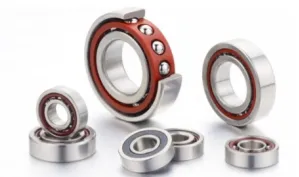
Angular contact ball bearings can bear both radial and axial loads, which can work at a higher speed. The larger the contact angle, the higher the axial bearing capacity. The contact angle is the angle between the connecting line of the contact point between the ball and the raceway in the radial plane and the vertical line of the bearing axis. High precision and high-speed bearings usually have a contact angle of 15 degrees. Under the action of axial force, the contact angle will increase.
(1) Angular contact ball bearings are available in single row and double row configurations.
(2) Able to accommodate both radial and thrust loads
(3) Suitable for high speed operation
(4) Open and sealed versions available
(5) Highly rigid
(6) Standard: DIN 616, DIN 628
single row: 7200, 7300
double row: 3200, 3300, 5200, 5300
Gearboxes
Agricultural machinery
Pumps and compressors
Ventilators
Machine tools
etc.

DB : Two bearings matched back-to-back
DF : Two bearings matched face-to-face
DT : Two bearings matched in tandem
C: 15° contact angle
B : 40° contact angle
M: brass cage
P: nylon cage
*Single row angular contact ball bearings
718 Series Angular Contact Bearings
719 Series Angular Contact Bearings
70 Series Angular Contact Bearings
B70 Series Angular Contact Bearings
72 Series Angular Contact Bearings
Precision series (Reference super precision bearings series )
*Double row angular contact ball bearings
*Four-point contact ball bearings.
Parameter:
Suffixes – Internal design Stands for
A 30° contact angle
AB 20° contact angle (Inch bearing )
AC 25° contact angle
B 40° contact angle
E Optimized internal design
Suffixes – External design (seals, snap ring groove, execution etc.) Stands for
N1 One locating slot (notch) in one outer ring side face
CA Bearing for universal matching. Two bearings arranged back-to-back or face-to-face have axial internal clearance smaller than Normal (CB).
CB Bearing for universal matching. Two bearings arranged back-to-back or face-to-face have Normal axial internal clearance.
CC Bearing for universal matching. Two bearings arranged back-to-back or face-to-face have axial internal clearance greater than Normal (CB).
G Bearing for universal matching. Two bearings arranged back-to-back or face-to-face have axial internal clearance.
GA Bearing for universal matching. Two bearings arranged back-to-back or face-to-face have light preload.
GB Bearing for universal matching. Two bearings arranged back-to-back or face-to-face have moderate preload.
GZ Bearing for universal matching. Two bearings arranged back-to-back or face-to-face have heavy preload.
Suffixes – Cage design Stands For
F Machined steel cage, ball centred
J Stamped steel cage, ball centred
M Machined brass cage, ball centred; different designs are identified by a number following the M, e.g. M2
MB Machined brass cage, inner ring centred
P Glass fibre reinforced PA66 cage, ball centred
PH Glass fibre reinforced PEEK cage, ball centred
Y Stamped brass cage, ball centred
Suffixes – Accuracy, clearance, preload, quiet running Stands For
P5 Dimensional and running accuracy to P5 tolerance class
P6 Dimensional and running accuracy to P6 tolerance class
Suffixes – Bearing sets, matched bearings Stands For
DB Two bearings matched for mounting back-to-back
DF Two bearings matched for mounting face-to-face
DT Two bearings matched for mounting in tandem.